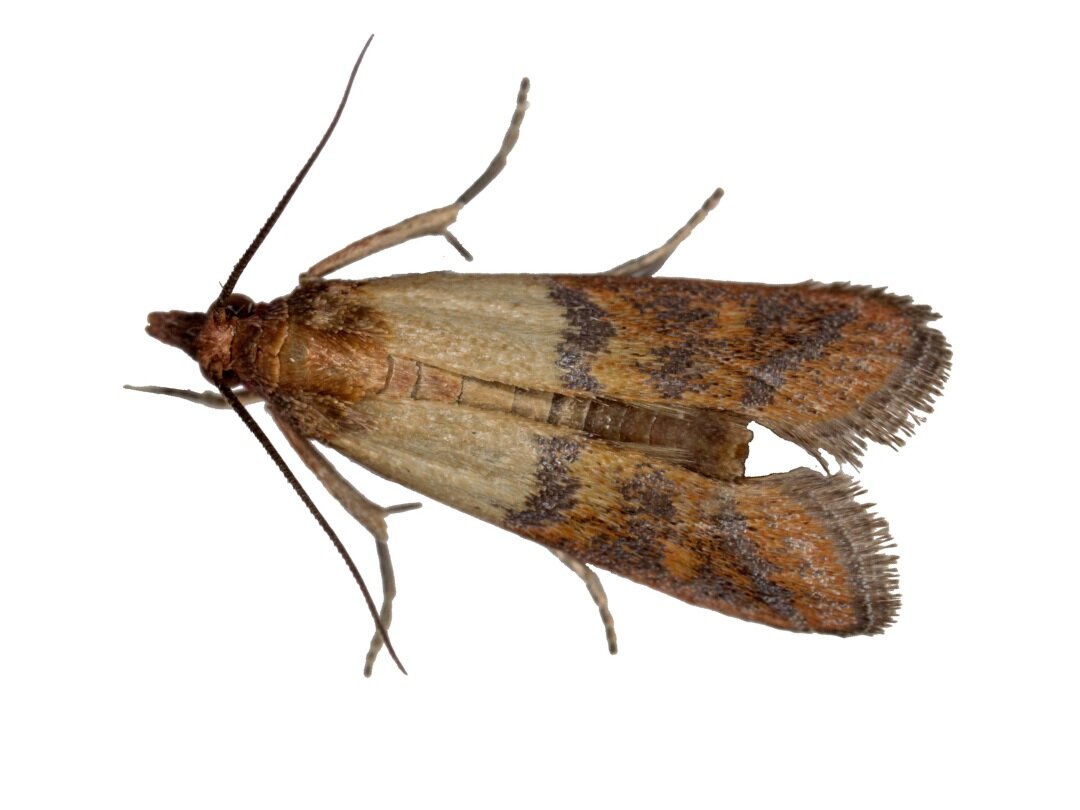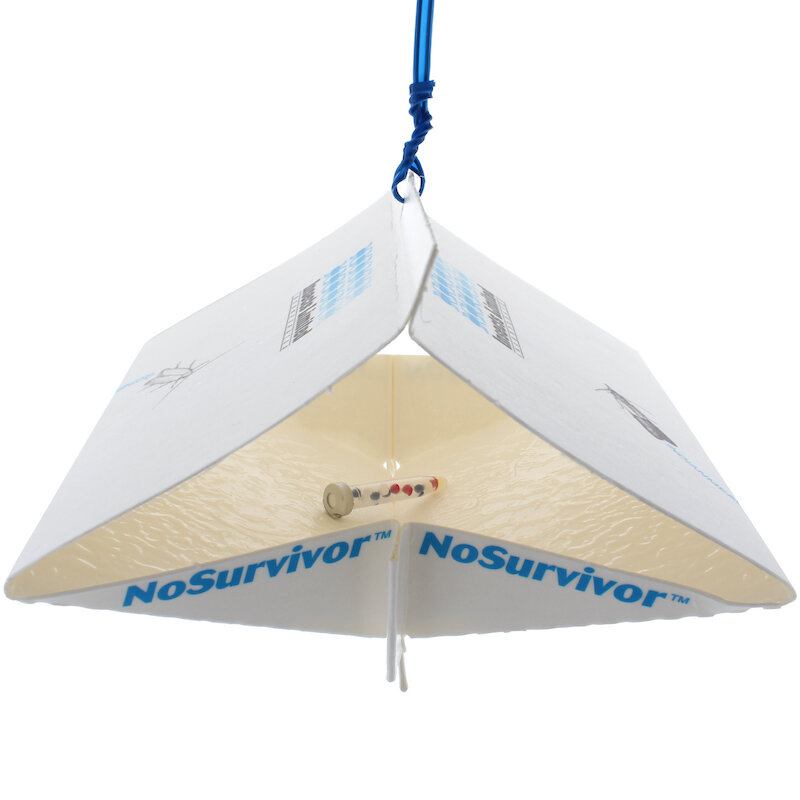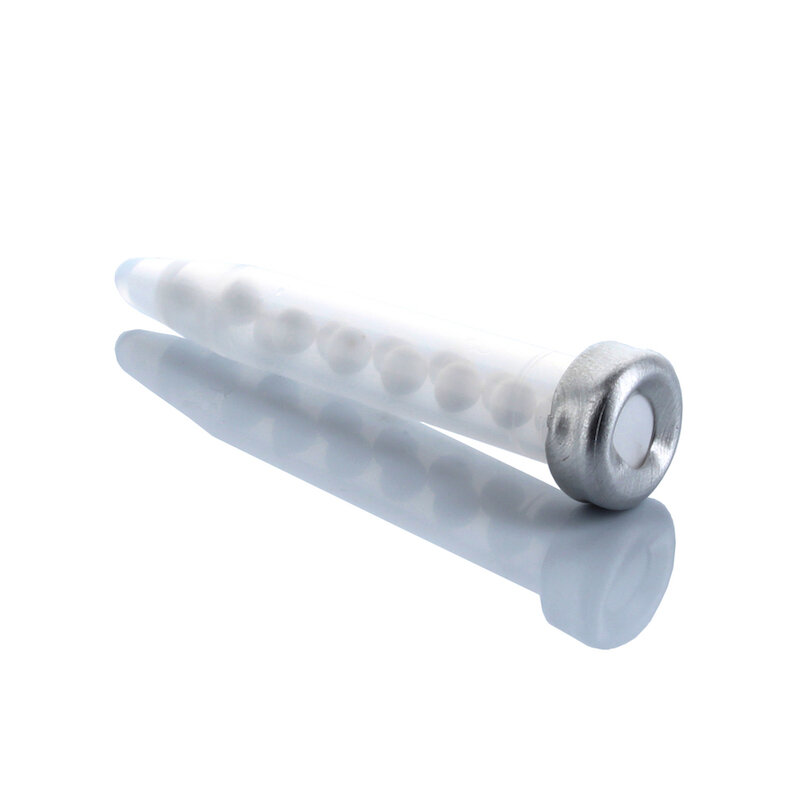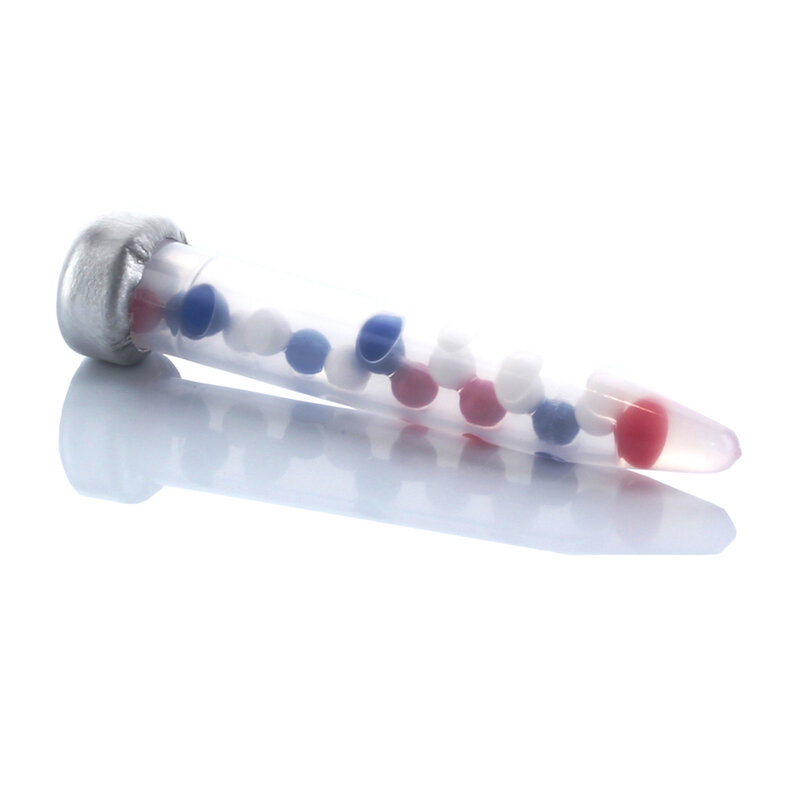Indian Meal Moth (Plodia interpunctella)
One insect is found more often than any other on stored food and grain in the United States. This is the dreaded Indian meal moth (IMM).
Since they feed on any items containing grain or cereal products, the Indian meal moth alone is responsible for most of the insect problems associated with the food industry. This is one of the easiest stored food insects to identify because the adults have a colorful appearance and the larvae (which look like yellow worms) leave a silken webbing trail wherever they crawl.
Newly emerged adults have bi-colored (copper and tan) wings and measure about 1/2" from top to bottom. The IMM larvae most commonly feed on grain products including flour, cereal, nuts, bird seed and pet food.
Pheromone Traps for Indian Meal Moth
Indian Meal Moth Description
Adults: Up to 13mm (0.5inches) long with wings that have brown copper tips. The part of the wings closest to the head is off white.
Eggs: Oval, ivory in color and 2mm (0.08inches) long
Larvae: Creamy white, brown head capsule. Coloration varies from cream to light pink color, sometimes pale green.
Pupae: Pupal cases are whitish with a yellow to brownish colored pupa inside.
Indian Meal Moth Life Cycle
Adult Indian meal moths live for 10-14 days. Mated females can lay 200-400 eggs singly or in groups. Eggs hatch in 3-5 days in warmer months and up to 7 days in cooler months. Larvae feed and become mature in 21 days or if 30 days depending on food quality, temperature, and humidity. Larvae will wander and pupation will occur away from infested materials. Adults emerge from the pupae in 7 to 10 days depending on temperature.
Damage & Detection
Granular frass the size of ground pepper can be found in and on food materials such as nuts, dried fruits, cereals and processed foods containing nuts or seeds and made from wheat, rice or corn. The use of pheromone traps and inspections can determine location and degree of infestation
Fun Facts about the Indian Meal Moth
Similar species include the meal moth (Pyralis farinalis), Mediterranean flour moth (Ephestia kuehniella), Almond moth (Cadra cautella), raisin moth (Cadra figulilella), and dried fruit moth (Cadra calidella).
Other common names for the Indian meal moth include weevil moth, pantry moth, flour moth, and grain moth.
Like many food moth species, adult Indian meal moths do not eat. Their larvae are vivacious feeders and damage dried goods.
Larvae produce large amounts of silk which can contaminate dried food goods and clog machinery.
Indian meal moths initiate flight at temperatures above 12.5°C (55°F).
The pheromone that attracts the Indian meal moths also attracts over 20 other moth species (Ephestia spp., Cadra spp, and Spodoptera spp.).
Monitoring Tips & Tricks
Indian Meal Moth Monitoring Guidelines
Lure:
BULLET LURE® - Contains sex pheromone to attract male moths.
Lure Storage
Keep unopened lures in cool storage (less than 60° F) or place in freezer for extended storage. Lures can remain frozen for up to 24 months or at room temperature for 12 months to retain their full effectiveness for use afterwards.
Trap Designs Used with Lure NOSURVIVOR traps are diamond shaped sticky traps that can be hung from many locations. This design is the preferred trap for this moth that flies well.
THE SIGHTTRAP™ is the size of a NoSurvivor hanging trap and provides daily images and catch data to help with early detection. The data is available on the web and app-based software, ForesightIPM.
Indian Meal Moth Pheromone Traps
Pheromone Trap Placement & Use
Trap Placement Techniques
Pheromone traps can be placed out year-round but are especially recommended during warmer months when temperatures exceed 12.5°C (55°F). Place hanging Indian meal moth pheromone traps 1.5 m (5 feet) above ground or at eye level to allow for easy inspection when monitoring traps. In areas such as a pantry or home, place one or two pheromone traps per room.
In commercial areas such as warehouses or retail stores, place pheromone traps 7.5–15 m (25–50 feet) apart to determine the presence or absence of Indian meal moths. Increase pheromone trap density to 4.5–7.5 m (15–25 feet) apart to help locate the source of Indian meal moths.
Keep pheromone traps 7.5 m (25 feet) away from exterior doors. Indian meal moth pheromone traps are best utilized in areas that store dried goods such as food, grains, seeds, nuts, dried fruit, animal feed, or pet food.
Trap and Lure Maintenance
Replace traps when glue is filled with insects or becomes dusty. Replace pheromone lures every 90 days. Replace all pheromone lures in a location at the same time. Do not cut the cap off the bullet lure. Do not stagger lure replacement over several weeks. Record date and number of catches to identify trending information.
Indian Meal Moth FAQs
Where do Indian meal moths come from?
Indian meal moths are frequently found in nature feeding on fallen acorns, walnuts, hickory nuts or other tree nuts. They can also be found on most any dried seeds from plants and some dried plant leaves.
They eventually find their way indoors and infest our food supply in grain bins, food processing facilities, distribution warehouses, transportation vehicles, grocery stores and finally our homes. In kitchen pantries, they can be found infesting dried cereals, grains, pasta, flour, spices and other dried food goods.
They are voracious feeders on bird seed and dried pet foods. In neighborhoods with mature, nut-bearing trees, the moths often work their way indoors from the fallen nuts by first finding bird seed or pet food stored in a garage where the garage door remains open for extended periods of time. Mated females will lay their eggs on these products and the infestation begins.
What is the Indian meal moth life cycle?
The entire life cycle of an Indian meal moth can be as short as 6 weeks given warm temperatures and plenty of food. Adult moths live for 10-14 days. Mated females can lay 200-400 eggs singly or in groups.
Eggs hatch in 3-5 days in warmer months and up to 7 days in cooler months. Larvae feed and become mature in 21 days or as long as 30 days depending on food quality, temperature and humidity. Larvae will wander and pupation will occur away from infested materials. Adults emerge from the pupae in 7 to 10 days depending on temperature.
What do Indian meal moths look like?
Adults Indian meal moths are up to 13 mm (0.5 inches) long with wings that have copper brown tips. The part of the wings closest to the head is off white. Eggs are oval in shape, ivory in color and 2 mm (0.08 inches) long.
The eggs are usually too small to be seen by the naked eye. Indian meal moth larvae are creamy white in appearance with a brown head capsule. Coloration varies from cream to light pink color, sometimes pale green.
Pupae: Pupal cases are whitish with a yellow to brownish colored pupa inside.
How to get rid of Indian meal moths?
The use of pheromone traps, otherwise called pantry moth traps, can indicate the presence of Indian meal moths as well as where the moths are coming from.
A visual inspection of dried food in the vicinity of the pheromone traps containing the most moths can reveal specific items containing larvae, pupae and adult moths.
Once infested materials have been identified, they should be sealed up and discarded into an outdoor trash receptacle or the materials should be sealed in plastic and frozen for a 1 week period to kill all stages of the moths.
What is a good Indian meal moth treatment?
Infested items can be sealed and disposed of, or can be sealed in plastic and frozen for several days to kill all life stages of Indian meal moth. There is not a viable Indian meal moth repellent on the market that can solve a pest issue with these moths.
Join Our Informed Community
Receive the latest industry updates as soon as they are published.








